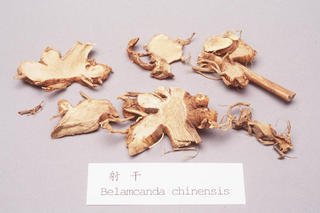Belamcanda chinensis
Contents
Nomenclature
Other Names:
Historical Use of Belamcanda chinensis
Belamcanda chinensis in Traditional Chinese Medicine
Background
Sheganpian Éä¸ÉƬ
Chinese Name (pinyin): Shegan
Chinese Name :
Common Name :Belamcanda Rhizome
Specific Name : Rhizoma belamcandae
Scientific Name:
Collection : The drug is collected in early spring while the plant budding or in the late autumn while the aerial part withering, removed from the fibrous root and soil and dried.
Description : Irregularly nodular, 3 - 10 cm long, 1 - 2 cm in diameter. Externally yellowish brown, dark brown or blackish brown, shrunken with abundantly annular striations. Several dish shaped and sunken stem scars occurring at the upper part, stem bases remained occasionally, remains of thin roots and root scars occurring at the lower part. Texture hard, fracture yellow, granular, odour slight, taste bitter and slightly pungent.
Identification : 1. Transverse section: Epidermis sometimes remaining. Cork containing of more layers of cells. Cortex sparsely scattered with leaf trace bundles, endodermis indistinct. Vascular bundles of stele amphivasal and collateral, densely arranged near the outer side parenchymatous cells containing columnar crystal of calcium oxalate, starch granules and oil drops.Powder: Orange, crystal of calcium oxalate abundant, columnar, often broken, the intact ones 49 - 240 -315 µm long, up to 49 µm in diameter. Simple starch granules sub rounded or elliptical, 2 - 17 µm in diameter, hilum dotted compound granules very occasional composed of 2- 5 components. Parenchymatous cells sub rounded or ellipsoidal, walls slightly thickened or beaded with simple pits. Cork cells brown, polygonal in surface view, walls thin and slightly sinuous, some containing brown contents.3.To 1 g of the powder add 10 ml of methanol, ultrasonicate for 30 minutes, filter evaporate the filtrate to 1.5 ml and use it as the test solution. Prepare a solution of Rhizoma Belamcandae reference drug in the same manner as the reference drug solution. Carry out the method for thin layer chromatography (Appendix Vl B) using polyamide film as the coating substance and chloroform-methanol-butanone (3:1:1) as the mobile phase. Apply separately 1 µl of each of the above two solutions to the film. After developing and removal of the membrane, dry it in the air, spray with aluminum chloride TS. Examine under ultra violet light (365 nm). The fluorescent spots in the chromatogram obtained with the test solution correspond in position and color to the spots in the chromatogram obtained with the reference drug solution.Extractives: Carry out the method for determination of extractives (Appendix X A, determination of ethanol soluble extractives), hot extraction method, not less than 18.0%
Processing : Eliminate foreign matter, wash clean, soften thoroughly, cut into thin slices and dry. In irregular or long slat shape, fracture yellow or brownish yellow. Carry out the determination of extractives as described above, not less than 18.0%.
Action : To remove toxic heat, eliminate phlegm, and soothe the sore throat.
Indication : sore throat, cough and dyspnea with copious expectoration due to accumulation of toxic heat, phlegm and fire
Precautions :
Dosage : 3 to 9 g.
Storage : Preserve in a dry place.
Synonymns for Belamcanda chinensis
Patent Medicines and Medicines with Multiple Ingredients that include Belamcanda chinensis
Pharmaceutical Information
Chemical Constituents
Evidence or the Use of Belamcanda chinensis in the Treatment of Epilepesy
Basic Science
Animal Studies
Cohort, Case-Control and Non-Randomized Trials
Randomized Controlled Trials
Meta-Analysis
1st Five Results: pubmed search
Yinan Zhao, Jiantong Hou, Yuhui Liu, Jing Xu, Yuanqiang Guo
An arabinose-rich heteropolysaccharide isolated from Belamcanda chinensis (L.) DC treats liver cancer by targeting FAK and activating CD40.
Carbohydr Polym: 2024, 331;121831
[PubMed:38388048]
[WorldCat.org]
[DOI]
(I p)
Zixuan Tang, Fuqiang Yin, Wanli Ma, Zhen Song, Qin Xu, Yuanhu Long, Yifeng Li, Ming Liu
##Title##
Plant Dis: 2024;
[PubMed:38197883]
[WorldCat.org]
[DOI]
(P a)
Manh Tuan Ha, Minju Gal, Jeong Ah Kim, Jeong-Hyung Lee, Byung Sun Min
Sucrosephenylpropanoid esters and isoflavonoids isolated from Belamcanda chinensis roots and their potential anti-osteoclastogenic activity.
Bioorg Chem: 2024, 143;107066
[PubMed:38185009]
[WorldCat.org]
[DOI]
(I p)
Tiannan Xiang, Yingxiang Zou, Xinru Jiang, Lirong Xu, Lu Zhang, Chunxian Zhou, You Hu, Xiaolan Ye, Xiao-Dong Yang, Xin Jiang, Yuejuan Zheng
Irisflorentin promotes bacterial phagocytosis and inhibits inflammatory responses in macrophages during bacterial infection.
Heliyon: 2024, 10(1);e23225
[PubMed:38170002]
[WorldCat.org]
[DOI]
(P e)
Kaiyue Zhang, Jingwei Lv, Jiaming Shen, Nanxi Zhang, Xiaochen Gao, Chunnan Li, Jiaming Sun, Yuelong Wang
Exploring Asthma Mechanism of Belamcanda Chinensis by "Dose-effect Weighted Coefficient" Network Pharmacology and Experiment Validation.
Comb Chem High Throughput Screen: 2023;
[PubMed:38155401]
[WorldCat.org]
[DOI]
(I a)
